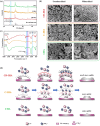Imperfect hydroxyapatite bioceramics derived from golden pomfret have enhanced osteogenic properties
- PMID: 40595986
- PMCID: PMC12217370
- DOI: 10.1038/s41598-025-06015-8
Imperfect hydroxyapatite bioceramics derived from golden pomfret have enhanced osteogenic properties
Abstract
Imperfect hydroxyapatite (IHA) bioceramics, which contain defects such as calcium deficiency, carbonate substitution, and metal cation substitution, exhibit improved osteogenic properties. In this study, we used a two-step calcination-hydrothermal process to manufacture two types of golden pomfret bone-derived imperfect hydroxyapatite bioceramics (G-IHA): carbonated calcium-deficient hydroxyapatite (CD-IHA) and carbonated hydroxyapatite (C-IHA). Their composition, surface morphology, zeta potential, degradation capacity, mineralization and osteogenic properties were systematically investigated. The results revealed that G-IHA with a higher defect content, including A-type carbonate substitution and Ca vacancies, had negatively charged surface. As a result, G-IHA surfaces are more favourable to ion exchange and interaction with cations (e.g., Na+, Ca2+) in the microenvironment, which results in improved degradation and mineralization. Specifically, after 28 days of degradation, G-IHA showed significantly higher weight losses (CD-IHA and C-IHA were 17% and 13%, respectively) than commercial hydroxyapatite (CHA; 7%). In addition, G-IHA have a higher better bone-like apatite formation ability, and a higher degree of osteogenic differentiation than CHA. Notably, carbonated calcium-deficient imperfect hydroxyapatite (CD-IHA) exhibited the highest bioactivity and osteogenic capacity as evidenced by its increased alkaline phosphatase activity and improved bone matrix mineralization capacity. In conclusion, this study revealed that imperfect hydroxyapatite bioceramics derived from golden pomfret bone have the potential to enhance osteogenic properties and be employed in clinical settings as bone substitute materials.
Keywords: Calcium-deficient hydroxyapatite; Carbonate substitution hydroxyapatite; Cation exchange; Enhanced osteogenic property; Golden pomfret bone.
© 2025. The Author(s).
Conflict of interest statement
Competing interests: The authors declare no competing interests.
Figures








Similar articles
-
Low-temperature plasma effect-induced enhancement of osteogenic activity in calcium phosphate ceramics.Acta Biomater. 2025 Jun 15;200:667-685. doi: 10.1016/j.actbio.2025.04.048. Epub 2025 May 2. Acta Biomater. 2025. PMID: 40319990
-
Mineralized osteoblast-derived exosomes and 3D-printed ceramic-based scaffolds for enhanced bone healing: A preclinical exploration.Acta Biomater. 2025 Jun 15;200:686-702. doi: 10.1016/j.actbio.2025.05.051. Epub 2025 May 21. Acta Biomater. 2025. PMID: 40409510
-
Antibacterial activity of carbonate hydroxyapatite-based honeycomb scaffolds doped with zinc for medical implants.Biomed Mater Eng. 2025 Jul;36(4):234-240. doi: 10.1177/09592989241313112. Epub 2025 Mar 13. Biomed Mater Eng. 2025. PMID: 40079779
-
Signs and symptoms to determine if a patient presenting in primary care or hospital outpatient settings has COVID-19.Cochrane Database Syst Rev. 2022 May 20;5(5):CD013665. doi: 10.1002/14651858.CD013665.pub3. Cochrane Database Syst Rev. 2022. PMID: 35593186 Free PMC article.
-
Behavioral interventions to reduce risk for sexual transmission of HIV among men who have sex with men.Cochrane Database Syst Rev. 2008 Jul 16;(3):CD001230. doi: 10.1002/14651858.CD001230.pub2. Cochrane Database Syst Rev. 2008. PMID: 18646068
References
-
- El-Rashidy, A. A., Roether, J. A., Harhaus, L., Kneser, U. & Boccaccini, A. R. Regenerating bone with bioactive glass scaffolds: a review of in vivo studies in bone defect models. Acta Biomater.62, 1–28 (2017). - PubMed
-
- Li, X. et al. Stabilization of Ca-Deficient hydroxyapatite in biphasic calcium phosphate ceramics by adding alginate to enhance their biological performances. J. Mat. Chem. B. 6, 84–97 (2018). - PubMed
MeSH terms
Substances
Grants and funding
LinkOut - more resources
Full Text Sources
Research Materials
Miscellaneous

